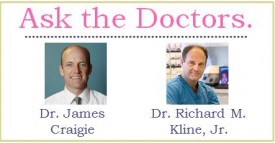Having breast reconstruction surgery is a big decision.
It’s only natural that there may be many questions floating around your head about having this procedure. Questions like…
- How much does the surgery cost?
- Will my insurance pay for the surgery?
- How long will it take me to heal and recover?
In order to get these questions answered, we highly encourage you to schedule an appointment with your doctor to get all the details.
In the meantime, however, our expert surgeons give some great insight into some of the most commonly asked questions.
Here’s what they have to say…
How Many Doctor Visits Does Reconstructive Surgery Take for Out of Town Patients?

Our P.A. Audrey and N.P. Lindsey spend a lot of time on the phone with out-of-town patients (and their local healthcare providers) before we ever see them, making sure that nothing important is overlooked before you make the trip to Charleston.
At some point, our surgeons have a phone consultation with future patients, so that they will have an opportunity to directly ask any questions they wish.
We usually see out of town patients for the first time the day before surgery. On that morning, they get an MR angiogram at Imaging Specialists of Charleston and then bring the disc to our office to help us plan their flap.
We operate the next morning, and our patients usually spend 4 nights in the hospital. You will typically follow up with your surgeon in our office 2 to 3 days after discharge.
We do our best to minimize the number of follow up visits by remotely managing post-operative care. Travel is a significant risk factor for blood clots, which is a risk of the surgery (as it is for many other surgeries).
Why Won’t Insurance Pay for Reconstruction?

Original Question: I don’t understand why the insurance company doesn’t pay for reconstruction if you’ve had a lumpectomy. With radiation, your breasts shrink a lot and you are all out of proportion.
Answer: Not getting insurance coverage is not always the case, especially with a lumpectomy.
If the surgery results in a significant defect or radiation negatively impacts the tissue, most times we can submit your case to your insurance company along with photos of the affected area, and they will indeed cover a reconstruction surgery for you.
Keep reading…
Would Reconstruction Be Successful for Me?

Fortunately, a history of radiation (and/or multiple failed attempts at implant reconstruction) does not at all decrease the success rate of subsequent reconstruction using only your own tissue.
We have successfully reconstructed hundreds of women who have had bad experiences in the past.
It is important to realize that natural tissue reconstruction is not just an operation, but a process. The first operation, the microsurgical transfer of the flaps, is by far the largest. It usually takes 6-8 hours, requires a 4-day hospital stay, and a total stay in Charleston of about a week. Recovery takes approximately 6-8 weeks.
After you have healed fully from the first surgery (usually 6 months if you have been radiated), 1-2 additional surgeries are required to achieve optimum results. These are much less involved, ordinarily requiring only one night in the hospital, and you can usually go back home as soon as you are discharged.
While the process can be lengthy, once you are done, you are REALLY done. Most women reconstructed with their own tissue come to regard their reconstructed breasts as their own, and are finally able to put the issue of breast cancer behind them.
Do you have breast reconstruction questions? Send us your questions here!













